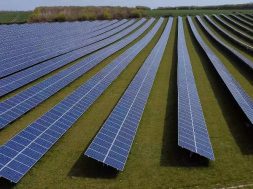
Mono-si Module Exports Experience Significant Growth in 2018; 2019 Mono-si Shipment Share to be on par with Multi-si
The market share for mono-si products has been catching up with the relatively more popular multi-si products in recent years, thanks to the growing maturity of the former technology’s supply chain. In the first three quarters of 2018, the share of mono-si modules in China’s total module exports hit an impressive 24.5%. This represents a major improvement over last year’s export share of 12.4%.
According to the customs data compiled by EnergyTrend, the export shares of mono-si modules (within wattage range between 250W and 390W) went up by over 100% sequentially in both the third and fourth quarters of 2017. As their export shares have been rising consistently throughout 2018, the dominance of the multi-si modules is expected to be challenged.

Japan has become the largest overseas market of the China-made mono-si modules, which accounted for 31.2% of China’s module export to the country in the first three quarters. By 3Q18, the share of its mono-si module exports to Japan increased to 35.9%, which is a far cry from the 13.7% share of the first three quarters of last year, and the 18% share for the entire 2017.

In terms of the mono-si module exports from China to Japan, the share of the over 300W mono-si modules in the export of China-made mono-si modules has risen to 64.5% in 2018, with that of the under 295W products reaching only 16%. This is vastly different from the situation in 2017, when the under-290W mono-si modules had the largest share of all mono-si module exports, followed by the 295W and above models. Overall, there have been no dominant suppliers for the Japanese market. For the 300W mono-si modules, LONGi has been the champion this year, with exports of 112.4 MW, followed by JA Solar with nearly 100 MW.
According to the statistics of the Japan Photovoltaic Energy Association (JPEA), with the exception of 1Q18, the shipment share of the mono-si modules in Japan has been trending upwards since 2Q17, and is almost equal to that of the multi-si modules in 2Q18.

72-cell mono-si modules receptive to large-scale power plants
In the first three quarters of 2018, the 300W products was the largest item for mono-si module export, with 1,241 MW in export volume, followed by the 345W products with 1,072 MW, and 340W products with 955 MW. The top five exporters for the three products are shown in the table below:

JinkoSolar landed orders for the 340-345W modules for the large-scale power plants from the Middle East and Australia, making it the champion in the export of 300/340/345 W mono-si modules, followed by LONGi. Mono-si export share in the two markets has been higher than the global average in 2018 thanks to procurement for large-scale PV power plants. In June alone, mono-si modules accounted for 66.6% of China’s module export to the Middle East.
Another noteworthy market is the recovering European market, whose import of China-made modules jumped by 34% sequentially in September, following the expiration of the region’s MIP (Minimum Import Price measurement) on September 3, which was driven by the shipment surge of mono-si modules.
China’s module exports cannot reflect the makeup of the European and U.S. markets, due to the significant amount of shipments from the overseas factories outside China as to skip trade barriers. A more accurate indicator is the export of China-made wafers, which boast over 97% share on the global market. As shown by EnergyTrend’s data, despite the slight decline in the export of China-made wafers, the production share of China-made mono-si wafers has been expanding at a nearly 50% clip since 2Q18, with its market share catching up with that of multi-si wafers quickly and possibly exceeding the latter by the end of 2020.

Mono-si global market share to reach close to 50% in 2019
According to EnergyTrend’s supply chain statistics, the production of mono-si wafers in 1Q18 grew to as high as 13.17 GW, despite the off season effects and the impact of China’s 531 policy. In 3Q18, the market share for mono-si wafers hit 46.1%, which is a record high. As the mono-si supply chain’s supplying capability and cost-performance ratio are improving, its share is expected to keep rising. EnergyTrend predicts that the total output and shipment volumes of mono-si wafers will gradually exceed those of multi-si wafers in Q4, due to the growing capacity utilization rate of the mono-si supply chain in the quarter, which is much higher than that of the multi-si supply chain.
In 2019, the total mono-si cell capacity will exceed 80GW, including over 70GW of mono-si PERC cells. Given mono-si PERC product’s high cost-performance ratio, its capacity utilization rate of their suppliers expected to stay high in 2019. As its utilization rate and production growth are expected to be higher than multi-si cells, the production share of mono-si cells in 2019 will approach 50%.

















